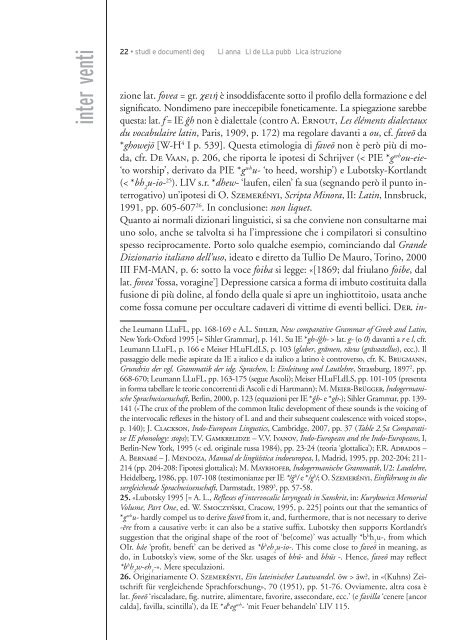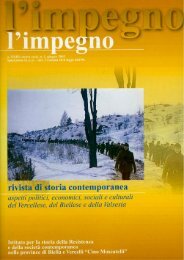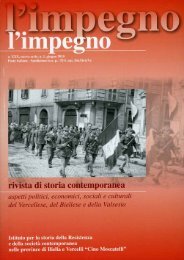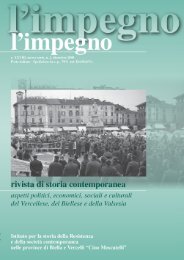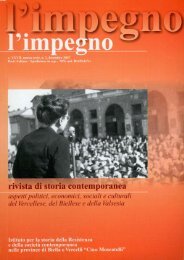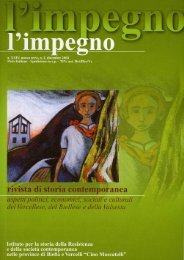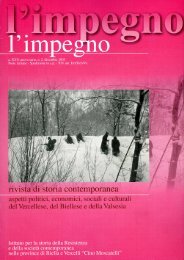Le vicende del confine orientale ed il mondo della scuola
Le vicende del confine orientale ed il mondo della scuola
Le vicende del confine orientale ed il mondo della scuola
You also want an ePaper? Increase the reach of your titles
YUMPU automatically turns print PDFs into web optimized ePapers that Google loves.
inter venti<br />
22 • studi e documenti deg Li anna Li de LLa pubb Lica istruzione<br />
zione lat. fovea = gr. ceihv è insoddisfacente sotto <strong>il</strong> prof<strong>il</strong>o <strong>del</strong>la formazione e <strong>del</strong><br />
significato. Nondimeno pare ineccepib<strong>il</strong>e foneticamente. La spiegazione sarebbe<br />
questa: lat. f = IE gˆ h non è dialettale (contro A. Ernout, <strong>Le</strong>s éléments dialectaux<br />
du vocabulaire latin, Paris, 1909, p. 172) ma regolare davanti a ou, cf. faveō da<br />
*ghowejō [W-H 4 I p. 539]. Questa etimologia di faveō non è però più di moda,<br />
cfr. De Vaan, p. 206, che riporta le ipotesi di Schrijver (< PIE *g wh ou-eie-<br />
‘to worship’, derivato da PIE *g wh u- ‘to he<strong>ed</strong>, worship’) e Lubotsky-Kortlandt<br />
(< *bh 2 u-io- 25 ). LIV s.r. *dhew- ‘laufen, e<strong>il</strong>en’ fa sua (segnando però <strong>il</strong> punto interrogativo)<br />
un’ipotesi di O. Szemerényi, Scripta Minora, II: Latin, Innsbruck,<br />
1991, pp. 605-607 26 . In conclusione: non liquet.<br />
Quanto ai normali dizionari linguistici, si sa che conviene non consultarne mai<br />
uno solo, anche se talvolta si ha l’impressione che i comp<strong>il</strong>atori si consultino<br />
spesso reciprocamente. Porto solo qualche esempio, cominciando dal Grande<br />
Dizionario italiano <strong>del</strong>l’uso, ideato e diretto da Tullio De Mauro, Torino, 2000<br />
III FM-MAN, p. 6: sotto la voce foiba si legge: «[1869; dal friulano foibe, dal<br />
lat. fovea ‘fossa, voragine’] Depressione carsica a forma di imbuto costituita dalla<br />
fusione di più doline, al fondo <strong>del</strong>la quale si apre un inghiottitoio, usata anche<br />
come fossa comune per occultare cadaveri di vittime di eventi bellici. Der. in-<br />
che <strong>Le</strong>umann LLuFL, pp. 168-169 e A.L. Sihler, New comparative Grammar of Greek and Latin,<br />
New York-Oxford 1995 [= Sihler Grammar], p. 141. Su IE *gh-/gˆh- > lat. g- (o 0) davanti a r e l, cfr.<br />
<strong>Le</strong>umann LLuFL, p. 166 e Meiser HLuFLdLS, p. 103 (glaber, grāmen, rāvus (grāvastellus), ecc.). Il<br />
passaggio <strong>del</strong>le m<strong>ed</strong>ie aspirate da IE a italico e da italico a latino è controverso, cfr. K. Brugmann,<br />
Grundriss der vgl. Grammatik der idg. Sprachen, I: Einleitung und Lautlehre, Strassburg, 1897 2 , pp.<br />
668-670; <strong>Le</strong>umann LLuFL, pp. 163-175 (segue Ascoli); Meiser HLuFLdLS, pp. 101-105 (presenta<br />
in forma tabellare le teorie concorrenti di Ascoli e di Hartmann); M. Meier-Brügger, Indogermanische<br />
Sprachwissenschaft, Berlin, 2000, p. 123 (equazioni per IE *gˆh- e *gh-); Sihler Grammar, pp. 139-<br />
141 («The crux of the problem of the common Italic development of these sounds is the voicing of<br />
the intervocalic reflexes in the history of L and and their subsequent coalescence with voic<strong>ed</strong> stops»,<br />
p. 140); J. Clackson, Indo-European Lingustics, Cambridge, 2007, pp. 37 (Table 2.5a Comparative<br />
IE phonology: stops); T.V. Gamkrelidze – V.V. Ivanov, Indo-European and the Indo-Europeans, I,<br />
Berlin-New York, 1995 (< <strong>ed</strong>. originale russa 1984), pp. 23-24 (teoria ‘glottalica’); F.R. Adrados –<br />
A. Bernabé – J. Mendoza, Manual de lingüística indoeuropea, I, Madrid, 1995, pp. 202-204; 211-<br />
214 (pp. 204-208: l’ipotesi glottalica); M. Mayrhofer, Indogermanische Grammatik, I/2: Lautlehre,<br />
Hei<strong>del</strong>berg, 1986, pp. 107-108 (testimonianze per IE */gˆ h / e */g h /; O. Szemerényi, Einführung in die<br />
vergleichende Sprachwissenschaft, Darmstadt, 1989 3 , pp. 57-58.<br />
25. «Lubotsky 1995 [= A. L., Reflexes of intervocalic laryngeals in Sanskrit, in: Kuryłowicz Memorial<br />
Volume, Part One, <strong>ed</strong>. W. Smoczyński, Cracow, 1995, p. 225] points out that the semantics of<br />
*g wh u- hardly compel us to derive faveō from it, and, furthermore, that is not necessary to derive<br />
-ēre from a causative verb: it can also be a stative suffix. Lubotsky then supports Kortlandt’s<br />
suggestion that the original shape of the root of ‘be(come)’ was actually *b h h 2 u-, from which<br />
OIr. báe ‘profit, beneft’ can be deriv<strong>ed</strong> as *b h eh 2 u-io-. This come close to faveō in meaning, as<br />
do, in Lubotsky’s view, some of the Skr. usages of bhū- and bhūs -. Hence, faveō may reflect<br />
*b h h 2 w-eh 1 -». Mere speculazioni.<br />
26. Originariamente O. Szemerényi, Ein lateinischer Lautwan<strong>del</strong>. ōw > āw?, in «(Kuhns) Zeitschrift<br />
für vergleichende Sprachforschung», 70 (1951), pp. 51-76. Ovviamente, altra cosa è<br />
lat. foveō ‘riscaladare, fig. nutrire, alimentare, favorire, assecondare, ecc.’ (e fav<strong>il</strong>la ‘cenere [ancor<br />
calda], fav<strong>il</strong>la, scint<strong>il</strong>la’), da IE *d h eg wh - ‘mit Feuer behan<strong>del</strong>n’ LIV 115.


